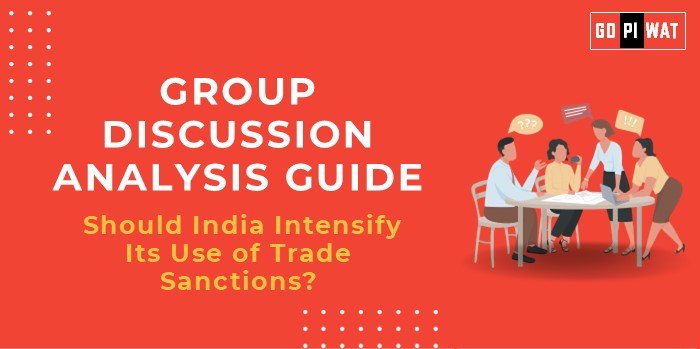📋 Group Discussion (GD) Analysis Guide: Should India Intensify Its Use of Trade Sanctions?
🌐 Introduction
Opening Context: Trade sanctions have become a pivotal tool in international relations, influencing global trade patterns and diplomatic strategies. With increasing geopolitical tensions, India faces a critical question: Should it intensify its use of this instrument?
Background: India’s stance on trade sanctions has traditionally been cautious, guided by its strategic autonomy. However, the global trade environment, marked by sanctions between major economies like the US and China, is reshaping the international order.
📊 Quick Facts & Key Statistics
- 🌍 India’s Export Share: 1.8% of global goods exports in 2023, reflecting steady growth in international trade.
- 📈 Trade Dependence: Merchandise imports of USD 677.24 billion in FY 2023-24 underscore India’s significant reliance on foreign goods.
- 💼 Major Trade Partners: China remains India’s largest trading partner with $118.4 billion in two-way commerce in FY 2023-24, followed by the United States.
- 🔄 Global Sanctions Trends: Increased trade sanctions between major economies such as the US and China are reshaping supply chains and global trade dynamics.
🤝 Stakeholders and Their Roles
- 🏛️ Indian Government: Responsible for crafting and enforcing trade sanctions policy.
- 🏢 Private Sector: Sectors such as technology, pharmaceuticals, and manufacturing depend on stable trade relations.
- 🌍 Global Organizations: WTO monitors compliance with international trade norms; UN influences sanctions through diplomatic resolutions.
- 🤝 International Partners: Allies and adversaries impacted by India’s sanctions policy, influencing bilateral ties and trade flows.
🏆 Achievements and Challenges
✔️ Achievements
- 🔒 Strategic restrictions on critical imports, fostering self-reliance.
- 🤝 Diplomatic gains through selective alignment with global sanctions (e.g., Iran).
- 📈 Growing exports in sectors like IT services and pharmaceuticals.
⚠️ Challenges
- 🚨 Potential retaliation affecting industries like textiles and agriculture.
- 📊 Dependency on China for key imports, risking economic fallout.
- 🔎 Limited institutional capacity for effective monitoring and enforcement.
🌍 Global Comparisons
- 🇨🇳 China: Strategic trade measures enhance its global influence.
- 🇺🇸 USA: Frequently employs sanctions, though with mixed outcomes.
📖 Case Study
India’s restrictions on Malaysian palm oil imports (2019) successfully recalibrated trade terms while demonstrating economic assertiveness.
💡 Effective Discussion Approaches
- 📊 Opening Techniques:
- “Trade sanctions have redefined global diplomacy, as seen in the US-China dynamic. Should India follow suit?”
- “With a trade dependence of over USD 677 billion in imports, sanctions could have far-reaching consequences.”
- ⚖️ Counter-Argument Handling:
- Acknowledge challenges but propose targeted sanctions to mitigate risks.
- Use examples like India’s strategic diversification in energy imports.
🛠️ Strategic Analysis of Strengths & Weaknesses
- 💪 Strengths: Emerging export power, strong diplomatic influence in South Asia.
- 🔻 Weaknesses: Heavy dependence on imports, limited enforcement capacity.
- 🌟 Opportunities: Leverage sanctions for geopolitical influence, enhance domestic manufacturing.
- ⚠️ Threats: Retaliatory sanctions, global supply chain disruptions.
🗣️ Structured Arguments for Discussion
- ✅ Supporting Stance: “A stronger sanctions policy can promote India’s strategic autonomy and reduce reliance on adversarial nations.”
- ❌ Opposing Stance: “Trade sanctions risk disrupting critical imports, harming domestic industries reliant on global supply chains.”
- ⚖️ Balanced Perspective: “India must weigh the benefits of strategic sanctions against the economic vulnerabilities they expose.”
📚 Connecting with B-School Applications
- 💼 Real-World Applications: Analyze sanctions in international trade modules or case studies on global supply chains.
- ❓ Sample Interview Questions:
- “How can India balance trade sanctions with its dependence on imports?”
- “What lessons can India learn from US-China trade dynamics?”
- ✨ Insights for Students: Understand the interplay between economic policy and diplomacy in global markets.


